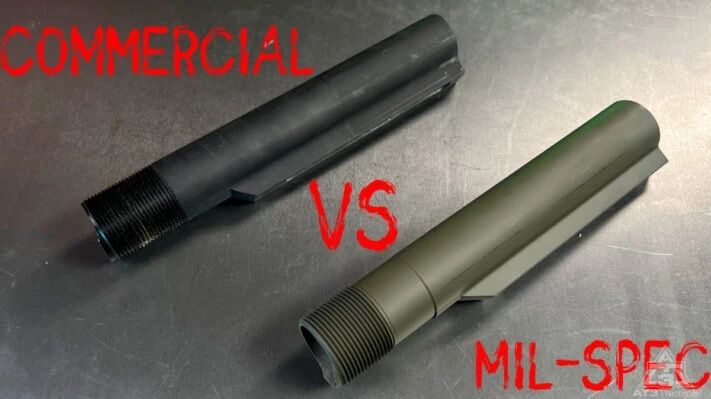
Buckle up, AR builders! Prepare for a surprising clash between stock and buffer tube combos. It’s mil-spec vs commercial AR15 buffer tubes—a thrilling showdown! Whether upgrading your AR-15 stock or embarking on an epic build, get ready for the exhilarating world of subtle differences and exciting similarities. Hold on tight for a wild ride!
Table of contents
- Understanding The AR 15 Buffer Tube
- Difference between an AR15 Mil-Spec Buffer Tube vs Commercial Buffer Tubes
- Common Buffer Tube Concerns
- Why Do Two Different Buffer Tube Standards Exist?
- Which One is Better? – MIL-SPEC VS COMMERCIAL BUFFER TUBE
- Mil-Spec VS Commercial Buffer Tube – Collapsing The Conversation
- FAQs
Understanding The AR 15 Buffer Tube
The AR-15 buffer tube (also known as the receiver extension), is the metal protrusion that sticks out of the rifle and serves two functions: it houses the recoil buffer mechanism, and it serves as the attachment point for the buttstock. The reason it’s referred to as a “buffer tube” is because inside the tube is a large spring (called the action spring or buffer spring), and a weighted part known as the “recoil buffer”.
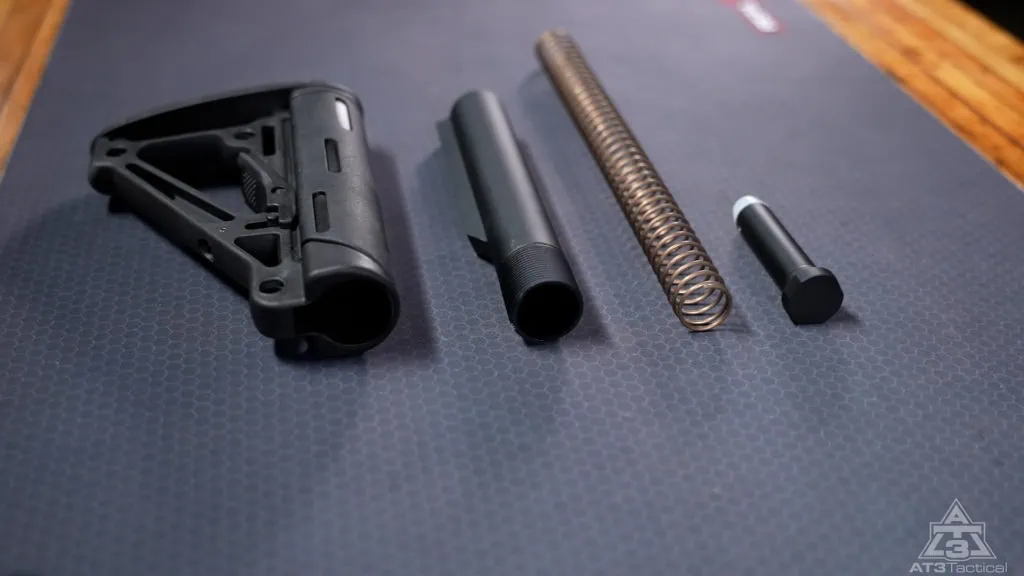
More info: When the rifle is “cocked” using the charging handle, the action spring is what makes the bolt slide back forward. Also, after a round is fired, the action spring is what pushes the bolt back forward and chambers the next round. The recoil buffer sits inside the spring, and its weight provides some “buffer” against the forces of recoil. By changing the weight of the buffer, you can change the characteristics of how the rifle cycles.

Difference between an AR15 Mil-Spec Buffer Tube vs Commercial Buffer Tubes
Now that you know what’s going on inside the tube, let’s examine the differences. The most critical difference is the diameter of the area where the stock slides onto the tube. The mil-spec buffer tube is about two-hundredths of an inch smaller than the commercial AR15 buffer tube. This may not sound like much, but it’s enough that the stock that is designed for one standard will not be compatible with the other.
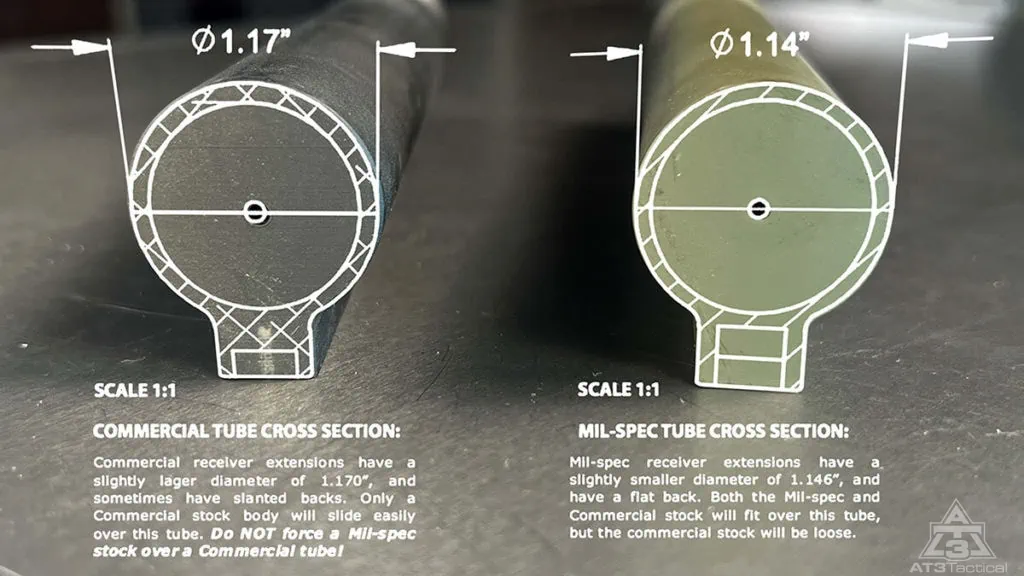
Other notable differences between the mil-spec and commercial buffer tubes can be things such as the angle of the back of the tube or the type of metal used. The problem is, these traits can vary by manufacturer, and are not necessarily related to the diameter of the tube or the fit of a stock.
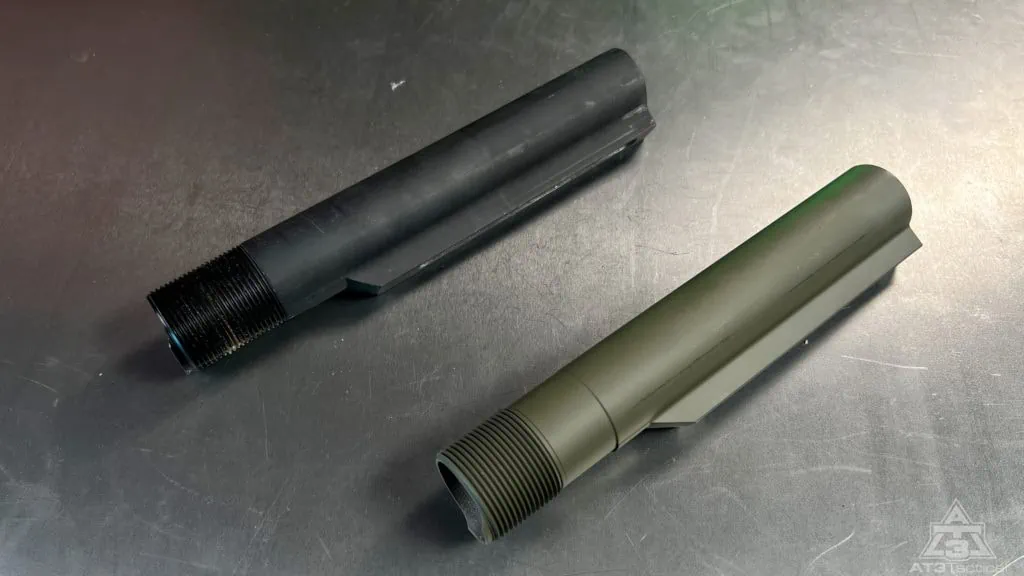
Common Buffer Tube Concerns
If you are concerned about fitment it is recommended to purchase the stock before the buffer tube. These days most stocks and buffer tubes are mil-spec but if there is any doubt pick out the stock first. This way you have the stock you want and just need to pair it to a buffer tube.
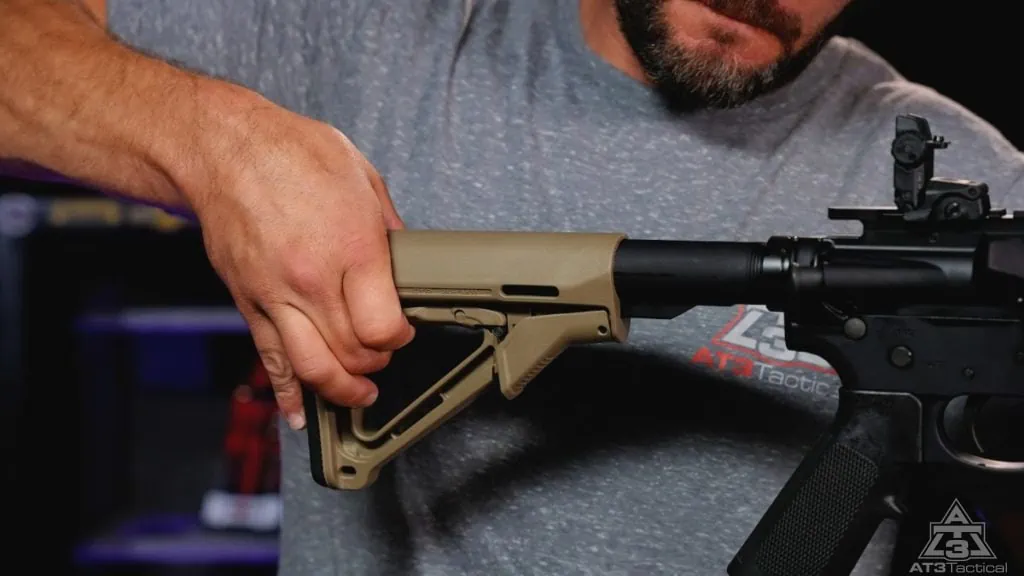
Some stocks come in both mil-spec and commercial varieties. The best way to measure a buffer tube type is by using a caliper or micrometer and measuring the diameter of the tube. A mil-spec tube should measure about 1.146”, and a commercial will be about 1.17”. If you were to acquire a stock meant for a commercial tube you could still use a mil-spec buffer tube but it will likely be loose and have some rattle.
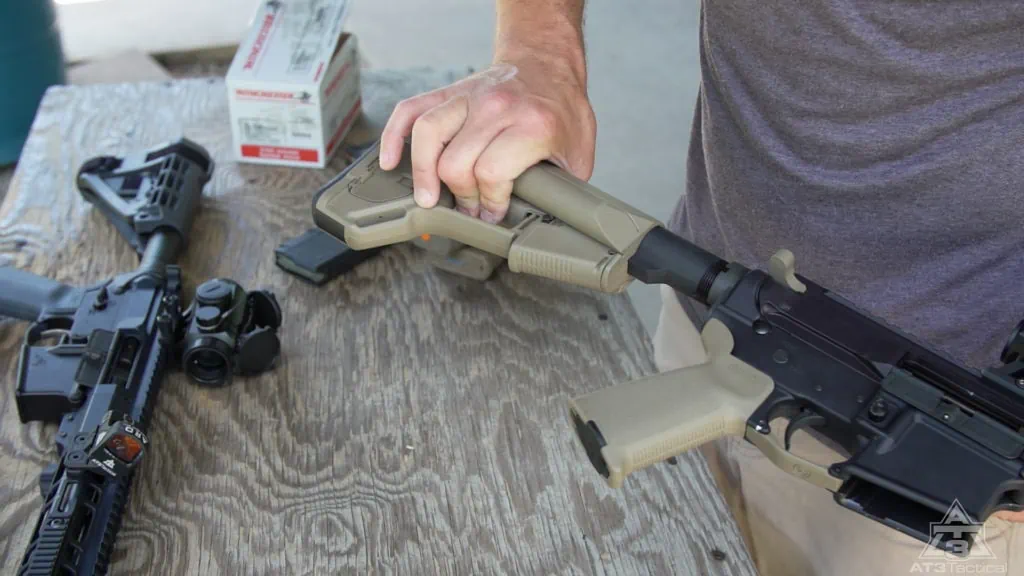
If you have any concerns installing a stock or buffer tube, feel free to check out this FREE Army Service Manual.
Why Do Two Different Buffer Tube Standards Exist?
As with so many things, it all comes down to money. The mil-spec buffer tubes were the original design, but the manufacturing processes of commercial spec buffer tubes provide a lower cost. In most cases, commercial tubes are of lower quality material (usually low-grade aluminum) and will often have lesser durability as a result.
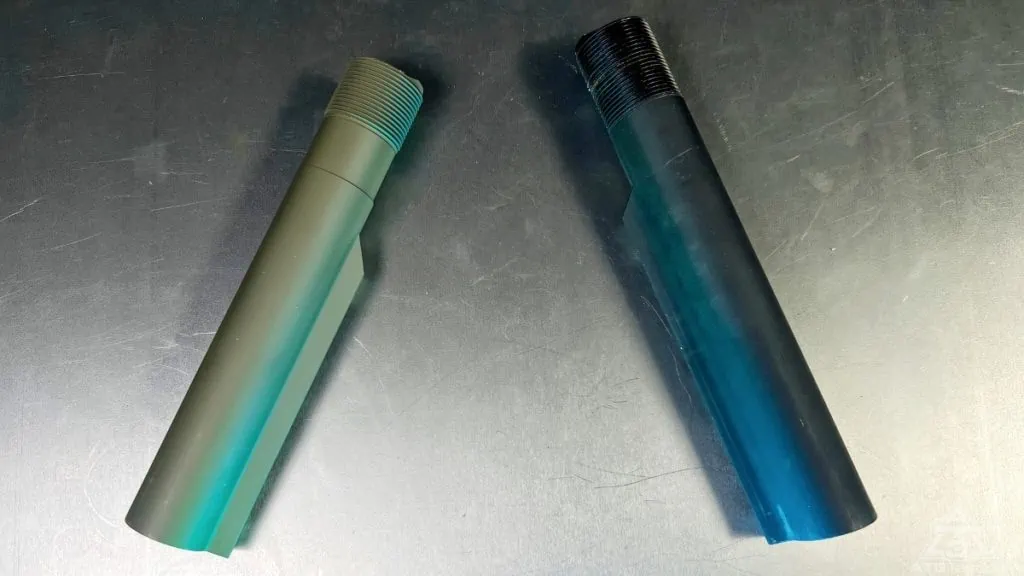
More info: When the M4 was first introduced as a military weapon, there was only one type of tube – mil-spec. But as the M4-pattern rifles moved into the civilian ranks, companies realized that they could make the tube cheaper. By making the tube a touch larger in diameter, the threads could be cut in, vs the mil-spec tube where the threads are rolled in.
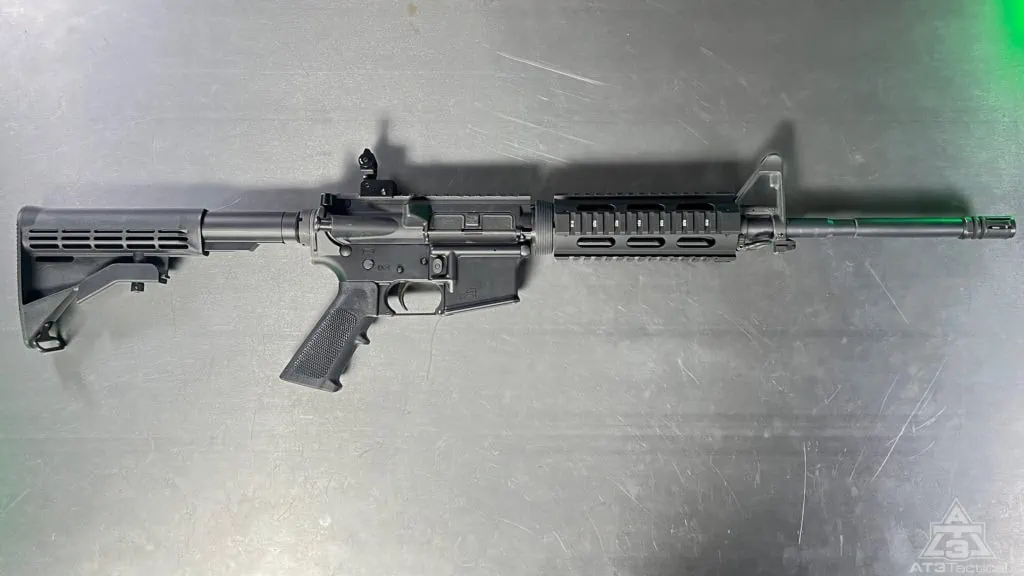
Which One is Better? – MIL-SPEC VS COMMERCIAL BUFFER TUBE
There are very few instances of the lesser quality materials coming factoring into buffer tube issues. There is little real-world evidence supporting that one standard is noticeably “better” than the other. We could take the literal “military specification” into consideration since their buffer tubes are designed with harder use and higher quality in mind. It could be argued for that fact alone that the mil-spec buffer tubes are better.
Mil-Spec VS Commercial Buffer Tube – Collapsing The Conversation
When choosing a stock and buffer tube combination, several factors come into play. Your favorite stock may only fit a commercial buffer tube, while mil-spec buffer tubes are more readily available. For most real-world cases, either option works fine. However, we here at AT3 Tactical recommend a mil-spec buffer tube due to greater aftermarket stock options and a perceived increase in strength (again, this lacks the “boots on the ground” evidence we would like to see).
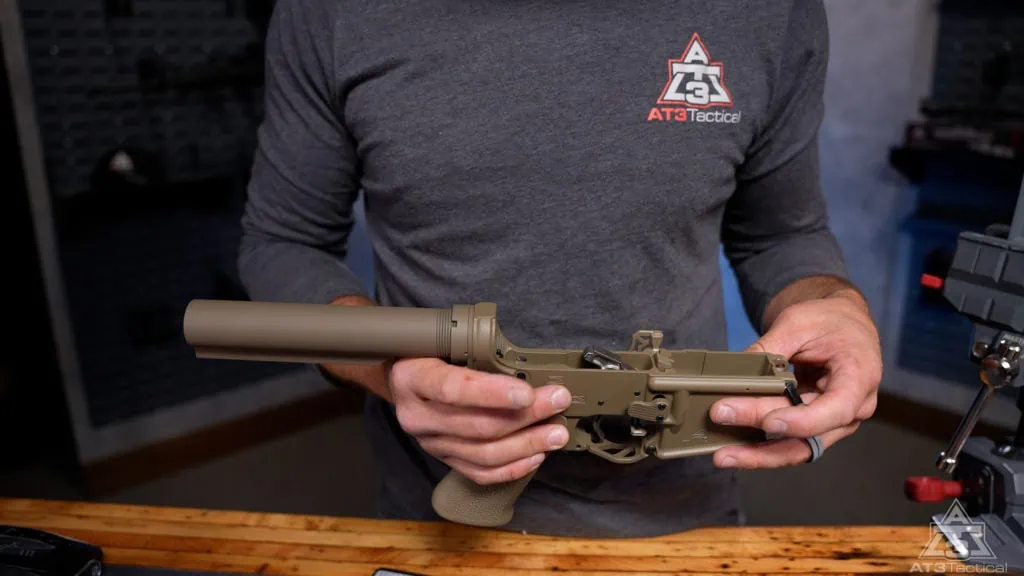
We at AT3 Tactical just want to lend our thanks to anyone who tunes in for the AT3 Blog and Youtube Channel. It is much appreciated and we are happy to continue to churn out quality and helpful content. It is an honor to be of service. Please let us know if you have any questions in the comments below. Be safe out there and we will catch you next time!
FAQs
The vast majority of stocks or buffers will be mil-spec these days but if you are unsure you can measure the buffer tube if you have one or start with purchasing a mil-spec stock and then get a mil-spec buffer tube. The best way to measure a buffer tube type is by using a caliper or micrometer and measuring the diameter of the tube. A mil-spec tube should measure about 1.146”, and a commercial will be about 1.17”.
Yes, but it will be noticeably loose. On the flip side of the coin, you cannot put a mil-spec stock on a commercial buffer tube. The tube is too wide.
No. Buffers and buffer springs can be used in either one.
Since commercial buffer tubes are proprietary and non-standardized it is likely there are some that do not have a slanted back. Most, however, do.
A mil-spec tube should measure about 1.146”, and a commercial will be about 1.17”. Commercial tubes may vary by a larger degree since it is not standardized.
One Last Tip
If there’s anyone that knows the AR-15 platform, it’s the US military. As a special offer for our readers, you can get the Official US Army Manual for AR-15/M4/M16 right now – for free. Click here to snag a copy.

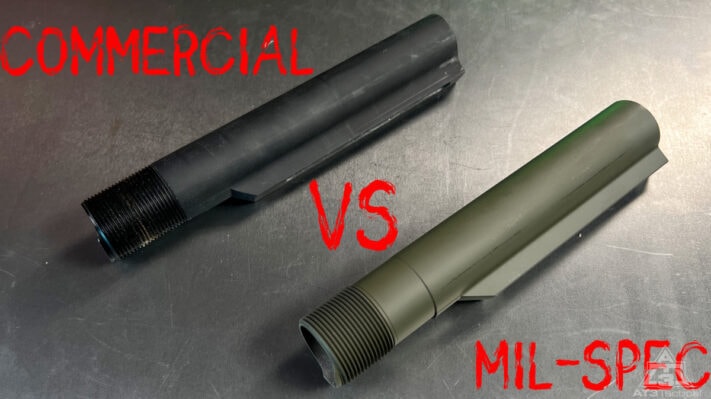

The author must’ve flunked math. There is only about .020″ (twenty-thousandths of an inch) difference between the two, not .200″ (two-hundred thousandths of an inch).
“The most critical difference is the diameter of the area where the stock slides onto the tube. The mil spec buffer tube is about two hundredths of an inch smaller than commercial.”
Who flunked math?
Decimals start at tenths, then hundredths, then thousandths..
BTW two hundredths and twenty thousandths are equivalent.
Two hundredths and twenty thousandths are NOT equivalent. Two hundredths is .200″ which is larger than 1/8″ (.125″), in fact it’s almost 1/4″ (.250″). Twenty thousandths is .020″ which is just a little larger than 1/64″ (.015″). Someone needs to take a basic math class, apparently.
TJT,
You sir are the one that does not understand basic math… 0.200 is two tenths. O.020 is two hundredths and equal to twenty thousandths. Decimal places matter, and by a factor of ten to be exact.
I concur with MADDMAXX.
NO. 0.200 is two-hundred-thou. Nobody in manufacturing will ever call that two tenths. 0.001 is standard mfg increment. 0.0200 is twenty-thou. 0.0020 is two-thou, and 0.0002 is two-tenths.
I really like the information I found please continue thank you
When looking to get a new buffer tube I stick with mil-spec , there are more selections of stocks to choose from. I also get what manufacturers called enhanced buffer tubes . They have tabs at the bottom of the threaded end and a slot cut for the spring and buffer detent . These extended tabs cradle the bottom of the bcg . The bcg will be resting partially in the buffer tube which creates a smoother recoil action and eliminates BCG tilt .
I bought an mp 15 S&W carbine how do I Know if it is commercial or Mil spec??
Thanks
If I have a mil-spec lower receiver, can I screw on a commercial receiver tube or are they different size and thread?
That is answered in the article and in this very thread…
I was always wondering why my buttstock was loose on my ar build. Measured both and found buffer tube was mil-spec and buttstock commercial.
Do they make a rifle length tube that is mil-spec that a mil-spec buttstock will fit on?
Thanks,
Jim Jinks
I mean sure, it had nothing to do with creating a competing standard to F! people over…. right?
I am building a .458 SOCOM. Do I need a heavier buffer spring and buffer than the standard AR-15 Mil Spec Buffer Tube Assembly?
Will the mil spec kit fit on a Windham AR 15? Or when u go to purchase online do u need to know what ur gun will hold size wise?
Yes
Another comment regarding strength, Mil-Spec buffer tubes are available in 6063 T6 aluminum alloy and 7073 T6 aluminum alloy. 7073 is roughly twice the strength of 6063, for that reason it’s marketed as Heavy Duty when choosing buffer tubes. A 7073 tube will cost more than a 6063 tube. Commercial buffer tubes only come in 6063 T6 alloy. Whether you’re building or trading out parts, one should ask themselves what level of activity you’re going to engage in, and how muvh potential abuse will the stock receive. If it’s going to be used and potentially abused in the field, go for the heavy duty 7073 tube. If it’s your blanket darling and only fired at the range, then go with the cheaper 6063 tube.
The Alloy’s are 6061-T6 and 7075-T6 Aluminum. You need to get your numbers right. However, I somewhat agree with your comment. For as little difference that there is between the two Alloy’s in cost, I would suggest that you always go with the 7075-T6. Because the bottom line is that regardless of why you built your new baby it should always be up to the task of taking a beating. You never know where life will take you and that little number between the two could be the difference between a go/no-go situation. Is it really worth it to save a few dollars. Not in my world.
When looking to get a new buffer tube I stick with mil-spec , there are more selections of stocks to choose from. I also get what manufacturers called enhanced buffer tubes . They have tabs at the bottom of the threaded end and a slot cut for the spring and buffer detent . These extended tabs cradle the bottom of the bcg . The bcg will be resting partially in the buffer tube which creates a smoother recoil action and eliminates BCG tilt .
You ask for proof for one over the other.
Rolled threads (mil spec) are stronger that cut
Threads, especially on such a thin walled tube.
40 year machinist
If the difference in tube size is actully about .020″. then the 1st comment is true. Otherwise the difference would be .054″.
Hi Derrick, the only thing you need need to replace is the buffer tube itself. The spring, buffer, and other parts are all interchangeable. Something like this would work: https://at3tactical.com/products/at3-tactical-mil-spec-buffer-tube-ar-15
Hi,
so… if I’ve bought an M4 with a native commercial tube, and I would like to change it with a Mil-spec tube, the lower will accept the new tube?
The threads is the same?
Thanks…
i have a commercial buffer tube assembly on a ar 15. is there a conversion kit to go to
the mil-spec system?
Yes. Buy a Mil-spec buffer tube. You cannot shrink the aluminum tube down.